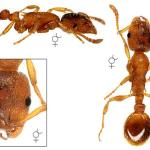Leptothorax acervorum is the only species remaining in Leptothorax after the other four British species were moved to Temnothorax (Bolton 2003). L. acervorum are small myrmicine ants with distinct propodeal spines and three-segmented antennal clubs. L. acervorum are larger than the British Temnothorax species and can be distinguished by an 11-segmented antenna in the females (12 in males); the Temnothorax species have one extra funicular segment.
Leptothorax acervorum is widely distributed throughout England, Wales, Scotland and Ireland. It is relatively abundant throughout its range from Cornwall to northern Scotland and can be found quite readily in most areas, apart from extreme urban and intensively agricultural sites. The species is more commonly associated with inland rather than coastal sites. This species occurs from Arctic Scandinavia south to southern Europe, and across Asia to Japan.
This ant is not regarded as being scarce or threatened.
The flights of L. acervorum males and gynes usually occur in mid-summer and are inconspicuous.
Workers of L. acervorum forage singly and unobtrusively, mainly in search of carrion, although they may tackle very small and weak invertebrates. Homoptera are not actively tended for their honeydew. They forage over the ground and rock surface or amongst fallen dead wood and leaf litter and can often be found taking scraps of food, dead corpses and nest rubbish from around the colonies of other much larger ants such as Formica species. They are rarely bothered by the larger ants due to their stealthy and appeasing nature and L. acervorum nests can also often be found in close association with those of other species.
In Britain no parasitic ant species is known to be associated with L. acervorum.
1998


